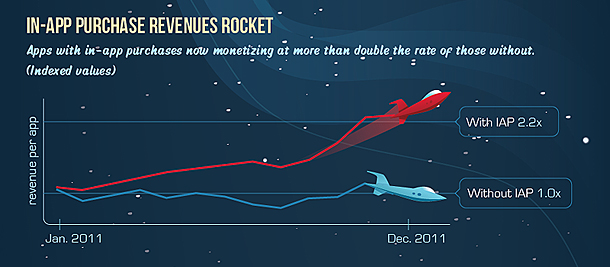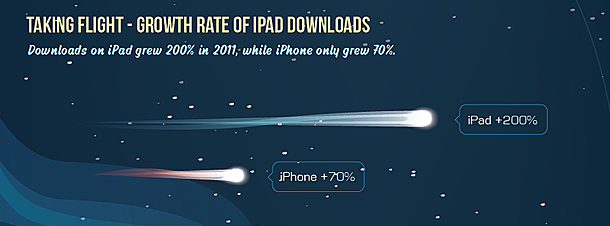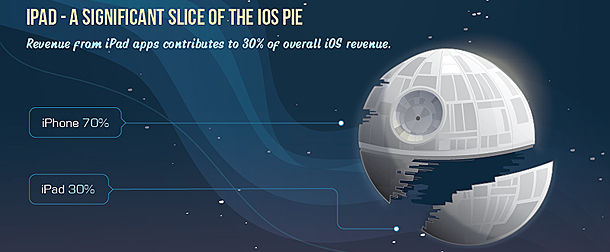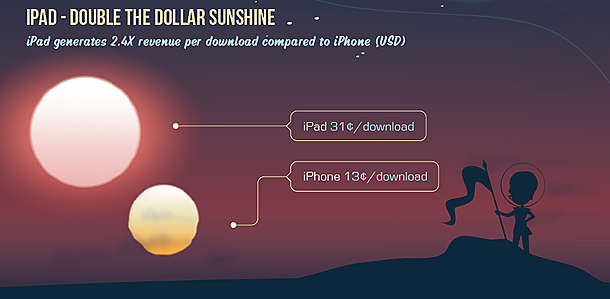7 major trends in the mobile industry
Analysts from the App Annie service, known to all mobile developers, shared excellent infographics, revealing the seven main trends in the mobile segment of the gaming industry. We processed the material a bit and wrote about each item.

The infographic is called The Rise of the Planet of the Apps (almost the same as last year's film about the revolt of the apes), the original can be seen here .
1. East Asia - the land of growing downloads
Last year, Apple harvested a good crop in China, Taiwan, Japan and Korea. The Chinese “lands” turned out to be especially fertile: it was on them that there was an increase in downloads of 298% and revenue growth of 187%. In Japan, the results are also good, but more modest: 98% increase in downloads and 88% increase in revenue.

From all this it follows that international publishers still have to plow and plow these lands: there is not only a huge army of consumers of products, but also impressive growth rates. By the way, bestsellers like Angry Birds and Fruit Ninja have their fans in the East for a long time. The main problem here is perhaps the fight against clones.
2. Norway - the planet of expensive downloads. The
number of downloads is not always the best indicator; Conversion is much more interesting, i.e. how many real sales these downloads account for. As it turned out, in the most expensive European country, the average income from each download is the largest in the world.

For one load in the country of fjords and harsh sailors-fishers, there is 0.37 dollars - this is 9 times more than in China.
3. Most money in the USA and Japan
Nobody has ever questioned the US “money”, but it’s still interesting to know that the # 1 application in American Top Grossing earns 10 times more than the most profitable Chinese application.

But a 10% figure may come as a surprise: it’s just so much less money that the top-end application in the Japanese App Store brings. Those. in Japan, revenue from applications from Top Grossing is not much less than in the US, while smartphone users are significantly less. This is another “plus” to the question of the need for localization.
4. In-app purchase revenues are growing by leaps and bounds
A significant increase in the number of shareware applications and, consequently, in-game payments revenue has occurred recently.

In January 2011, one hundred top-end applications with micropayments and one hundred top-end applications without them earned the same amount (per application). In December 2011, IAP applications earned 2.2 times more than non-transactional applications. So if you are going to earn millions on your new game, use the free-to-play mechanics.
By the way, leading publishers have long been working in this way.
5. Downloads on the iPad “skyrocketed”
“I already have a Macbook Air and an iPhone, so why do I need an iPad?”, Despite this familiar and still unresolved question, the number of downloads on the iPad in 2011 alone increased by 200%. For comparison, their growth on the iPhone showed only 70%.

App Annie also claims that by 2015, tablets will occupy 60% of the PC device market.
6. iPad - a huge piece of iOS pie

iPad tablets currently provide 30% of iOS revenue - the remaining 70% come to iPhone and iPod Touch.
7. iPad collects twice as much money
iPad's screen size is almost twice as large as the iPhone’s resolution, and perhaps because of this, each download to an i-tablet brings 2.4 times more than to an Apple smartphone.

Among other factors that can determine such a significant difference in "revenue": the difference in the prices of applications, as well as how users use these devices.
Based on materials from the App2Top.ru portal

The infographic is called The Rise of the Planet of the Apps (almost the same as last year's film about the revolt of the apes), the original can be seen here .
1. East Asia - the land of growing downloads
Last year, Apple harvested a good crop in China, Taiwan, Japan and Korea. The Chinese “lands” turned out to be especially fertile: it was on them that there was an increase in downloads of 298% and revenue growth of 187%. In Japan, the results are also good, but more modest: 98% increase in downloads and 88% increase in revenue.

From all this it follows that international publishers still have to plow and plow these lands: there is not only a huge army of consumers of products, but also impressive growth rates. By the way, bestsellers like Angry Birds and Fruit Ninja have their fans in the East for a long time. The main problem here is perhaps the fight against clones.
2. Norway - the planet of expensive downloads. The
number of downloads is not always the best indicator; Conversion is much more interesting, i.e. how many real sales these downloads account for. As it turned out, in the most expensive European country, the average income from each download is the largest in the world.

For one load in the country of fjords and harsh sailors-fishers, there is 0.37 dollars - this is 9 times more than in China.
3. Most money in the USA and Japan
Nobody has ever questioned the US “money”, but it’s still interesting to know that the # 1 application in American Top Grossing earns 10 times more than the most profitable Chinese application.

But a 10% figure may come as a surprise: it’s just so much less money that the top-end application in the Japanese App Store brings. Those. in Japan, revenue from applications from Top Grossing is not much less than in the US, while smartphone users are significantly less. This is another “plus” to the question of the need for localization.
4. In-app purchase revenues are growing by leaps and bounds
A significant increase in the number of shareware applications and, consequently, in-game payments revenue has occurred recently.

In January 2011, one hundred top-end applications with micropayments and one hundred top-end applications without them earned the same amount (per application). In December 2011, IAP applications earned 2.2 times more than non-transactional applications. So if you are going to earn millions on your new game, use the free-to-play mechanics.
By the way, leading publishers have long been working in this way.
5. Downloads on the iPad “skyrocketed”
“I already have a Macbook Air and an iPhone, so why do I need an iPad?”, Despite this familiar and still unresolved question, the number of downloads on the iPad in 2011 alone increased by 200%. For comparison, their growth on the iPhone showed only 70%.

App Annie also claims that by 2015, tablets will occupy 60% of the PC device market.
6. iPad - a huge piece of iOS pie

iPad tablets currently provide 30% of iOS revenue - the remaining 70% come to iPhone and iPod Touch.
7. iPad collects twice as much money
iPad's screen size is almost twice as large as the iPhone’s resolution, and perhaps because of this, each download to an i-tablet brings 2.4 times more than to an Apple smartphone.

Among other factors that can determine such a significant difference in "revenue": the difference in the prices of applications, as well as how users use these devices.
Based on materials from the App2Top.ru portal
